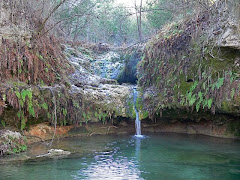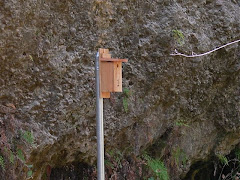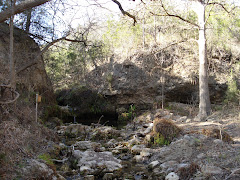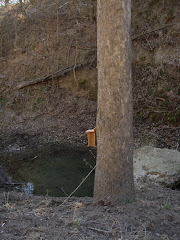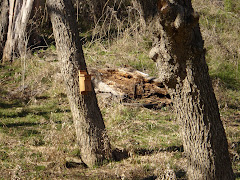 Overcast skies and the threat of rain did not keep the birds away on this beautiful Spring day in Texas Hill Country. I biked to Tobacco Creek for the first nest box survey of the day. Just up hill from nest box #5 I identified the first Summer Tanager of the year. Moving over to East Park Boundary site, I was surprised by a Rufous Hummingbird protecting his patch of blooming Buckeyes. Click on the photo above to obtain a larger view of this bird. I am sure every Buckeye patch found along the Pedernales River are now being vigorously protected by male Hummingbirds, most of which are Black-chinned Hummingbirds.
Overcast skies and the threat of rain did not keep the birds away on this beautiful Spring day in Texas Hill Country. I biked to Tobacco Creek for the first nest box survey of the day. Just up hill from nest box #5 I identified the first Summer Tanager of the year. Moving over to East Park Boundary site, I was surprised by a Rufous Hummingbird protecting his patch of blooming Buckeyes. Click on the photo above to obtain a larger view of this bird. I am sure every Buckeye patch found along the Pedernales River are now being vigorously protected by male Hummingbirds, most of which are Black-chinned Hummingbirds. 
This week I saw a different variety of Buckeye blooming, the Texas Buckeye, with pale yellow flowers, in addition to the Red Buckeye. Butterflies continued to frequent these flowers as well as other flowering shrubs throughout the park.
I even saw White-lined Sphinx Moths, also known as
 hummingbird moths, flying around the Buckeye at Twin Falls. The Sphinx photo was taken in my back yard.
hummingbird moths, flying around the Buckeye at Twin Falls. The Sphinx photo was taken in my back yard.This is the second week in a row I saw and heard sing a Yellow-throated Vireo high up in a Bald Cypress tree along the river.
To finish out the day I drove slow along the road into the Picnic Area where I saw my first Ash-throated Flycatcher of the year. This is the same area I saw one last year. Finally, I ended up at the bird blind to report three White-crowned Sparrows and one White-throated Sparrow still lingering before their migration north to Canada.




